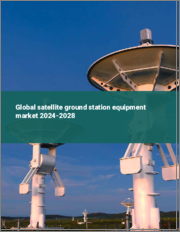
|
시장보고서
상품코드
1383261
세계의 위성 지상국 시장(2023-2033년)Global Satellite Ground Station Market 2023-2033 |
||||||
위성지상국은 우주에 있는 인공위성과의 통신에 사용되는 시설입니다. 위성과 지상의 통신 네트워크를 연결하는 중요한 역할을 하며, 위성과의 신호, 데이터, 지령 등을 주고받을 수 있도록 합니다. 지상국은 위성 통신 시스템의 중요한 컴포넌트로 통신, 방송, 원격탐사, 과학 연구 등 다양한 용도를 가능하게 합니다.
지상국에는 파라볼라 안테나, 위상배열 안테나 등 다양한 안테나가 설치되어 있습니다. 이들 안테나는 위성과의 신호를 수신하고 전송하는 역할을 합니다. 사용하는 안테나의 크기와 유형은 용도와 주파수 대역에 따라 결정됩니다.
지상국에서는 업링크 채널과 다운링크 채널이 분리되어 있습니다. 업링크 채널은 지상국에서 위성으로 신호를 전송하고, 다운링크 채널은 위성에서 신호를 수신합니다. 이 채널은 다양한 주파수 대기에서 작동하며, 가장 일반적인 것은 마이크로파 및 무선 주파수 대역입니다. 지상국에는 신호 송수신 장비인 트랜시버가 장착되어 있습니다. 송수신기는 전기 신호를 위성 통신의 주파수 대역으로 변환하는 역할을 합니다. 신호의 품질을 개선하고 전력 레벨을 관리하기 위해 증폭기, 필터 등의 RF(무선 주파수) 장비가 사용됩니다. 모뎀, 멀티플렉서, 복조기 등의 기반밴드 장비는 지상국에 설치되어 있습니다. 이 장비들은 신호를 처리하고 포맷하여 지상파 네트워크에서 전송 및 추가 처리를 위해 준비합니다.
추적 시스템은 상공을 이동하는 위성의 정확한 포인팅과 추적을 보장하기 위해 지상국에 내장되어 있습니다. 위성과의 지속적인 통신을 유지하기 위해 이러한 시스템은 일반적으로 전동식 안테나 마운트와 고급 추적 알고리즘을 채택합니다.
지상국은 위성 데이터를 처리하고 저장할 수 있는 컴퓨팅 능력과 데이터 저장 능력을 갖추고 있습니다. 여기에는 수신된 신호의 복호화, 복조, 분석과 추후 분석 및 전달을 위한 데이터 저장이 포함됩니다. 위성은 궤도 제어, 페이로드 운영, 시스템 유지보수 등 다양한 이유로 지상국으로부터 명령을 받습니다. 위성의 원격 측정 데이터는 위성의 건강, 성능 및 상태를 모니터링하는 데 사용됩니다. 지상국은 일반적으로 지상의 통신 네트워크로 연결되어 지상국과 최종사용자 및 기타 네트워크 노드 간의 데이터 및 신호 전송을 가능하게 합니다. 인터넷 접속, 전화, 비디오 방송과 같은 서비스는 이러한 연결성을 통해 가능합니다.
세계의 위성 지상국 시장을 분석했으며, 전체적인 시장 규모의 동향 전망 및 지역별·국가별 상세 동향, 주요 기술 개요, 시장 기회 등을 조사하여 전해드립니다.
목차
위성 지상국 시장 : 분석의 정의
위성 지상국 시장 내역
- 컴포넌트별
- 용도별
- 지역별
위성 지상국 시장 분석(향후 10년간)
위성 지상국 시장의 마켓 테크놀러지
세계의 위성 지상국 시장 예측
위성 지상국 시장 : 지역별 동향과 예측
- 북미
- 촉진·억제요인, 과제
- PEST 분석
- 시장 예측과 시나리오 분석
- 주요 기업
- 공급업체 계층 상황
- 기업 벤치마킹
- 유럽
- 중동
- 아시아태평양
- 남미
위성 지상국 시장 : 국가별 분석
미국
- 방위 계획
- 최신 동향
- 특허
- 이 시장에서 현재의 기술 성숙 레벨
- 시장 예측과 시나리오 분석
- 캐나다
- 이탈리아
- 프랑스
- 독일
- 네덜란드
- 벨기에
- 스페인
- 스웨덴
- 그리스
- 호주
- 남아프리카공화국
- 인도
- 중국
- 러시아
- 한국
- 일본
- 말레이시아
- 싱가포르
- 브라질
위성 지상국 시장 : 시장 기회 매트릭스
위성 지상국 시장 : 분석에 관한 전문가의 견해
결론
Aviation and Defense Market Reports 소개
KSA 23.12.05A satellite ground station, also known as an Earth station or ground terminal, is a facility used to communicate with space-based satellites. It acts as a vital link between satellites and terrestrial communication networks, allowing signals, data, and commands to and from satellites to be transmitted. Ground stations are critical components of satellite communication systems, enabling a variety of applications such as telecommunications, broadcasting, remote sensing, and scientific research.
Ground stations are outfitted with a variety of antennas, such as parabolic dish antennas and phased array antennas. These antennas are responsible for receiving and transmitting signals to and from satellites. The size and type of antenna used are determined by the application and frequency band.
Uplink and downlink channels are separate for ground stations. The uplink channel transmits signals from the ground station to the satellite, whereas the downlink channel receives signals from the satellite. These channels operate on various frequency bands, most commonly in the microwave or radio frequency spectrum. Ground stations are outfitted with transceivers, which are signal-transmitting and receiving devices. They are in charge of converting electrical signals into satellite communication frequency bands. To improve signal quality and manage power levels, RF (Radio Frequency) equipment such as amplifiers and filters are used. Baseband equipment such as modems, multiplexers, and demodulators can be found in ground stations. These devices process and format signals in preparation for transmission over terrestrial networks or further processing.
Tracking systems are built into ground stations to ensure precise pointing and tracking of satellites as they move across the sky. To maintain continuous communication with the satellites, these systems typically employ motorized antenna mounts and advanced tracking algorithms.
Ground stations have computing and data storage capabilities that allow them to process and store satellite data. This could include decoding, demodulating, and analyzing received signals, as well as storing the data for later analysis or distribution. Satellites receive commands from ground stations for a variety of reasons, including orbit control, payload operations, and system maintenance. They use satellite telemetry data to monitor their health, performance, and status. Ground stations are usually linked to terrestrial communication networks, allowing data and signals to be transferred between the ground station and end-users or other network nodes. Services such as internet access, telephony, and video broadcasting are made possible by this connectivity.
Table of Contents
Satellite Ground Station Market Report Definition
Satellite Ground Station Market Segmentation
- By Component
- By Application
- By Region
Satellite Ground Station Market Analysis for next 10 Years
- The 10-year access control market analysis would give a detailed overview of access control market growth, changing dynamics, technology adoption overviews and the overall market attractiveness is covered in this chapter.
Market Technologies of Satellite Ground Station Market
- This segment covers the top 10 technologies that is expected to impact this market and the possible implications these technologies would have on the overall market.
Global Satellite Ground Station Market Forecast
- The 10-year access control market forecast of this market is covered in detailed across the segments which are mentioned above.
Regional Satellite Ground Station Market Trends & Forecast
- The regional access control market trends, drivers, restraints and Challenges of this market, the Political, Economic, Social and Technology aspects are covered in this segment. The market forecast and scenario analysis across regions are also covered in detailed in this segment. The last part of the regional analysis includes profiling of the key companies, supplier landscape and company benchmarking. The current market size is estimated based on the normal scenario.
- North America
- Drivers, Restraints and Challenges
- PEST
- Market Forecast & Scenario Analysis
- Key Companies
- Supplier Tier Landscape
- Company Benchmarking
- Europe
- Middle East
- APAC
- South America
Country Analysis of Satellite Ground Station Market
- This chapter deals with the key defense programs in this market, it also covers the latest news and patents which have been filed in this market. Country level 10 year market forecast and scenario analysis are also covered in this chapter.
US
- Defense Programs
- Latest News
- Patents
- Current levels of technology maturation in this market
- Market Forecast & Scenario Analysis
- Canada
- Italy
- France
- Germany
- Netherlands
- Belgium
- Spain
- Sweden
- Greece
- Australia
- South Africa
- India
- China
- Russia
- South Korea
- Japan
- Malaysia
- Singapore
- Brazil
Opportunity Matrix for Satellite Ground Station Market
- The opportunity matrix helps the readers understand the high opportunity segments in this market.
Expert Opinions on Satellite Ground Station Market Report
- Hear from our experts their opinion of the possible analysis for this market.



















